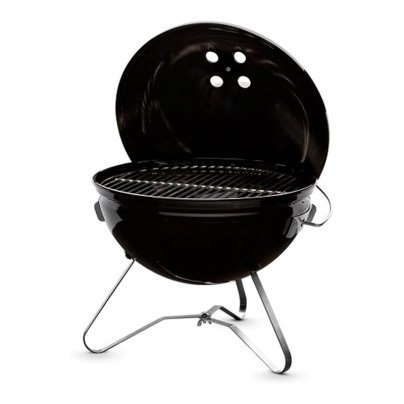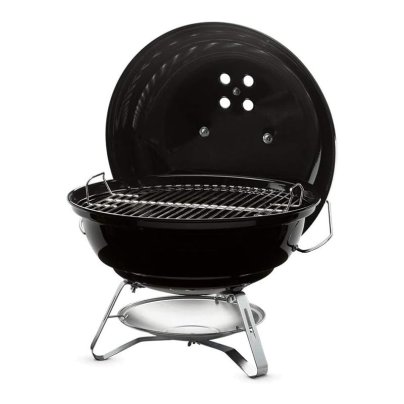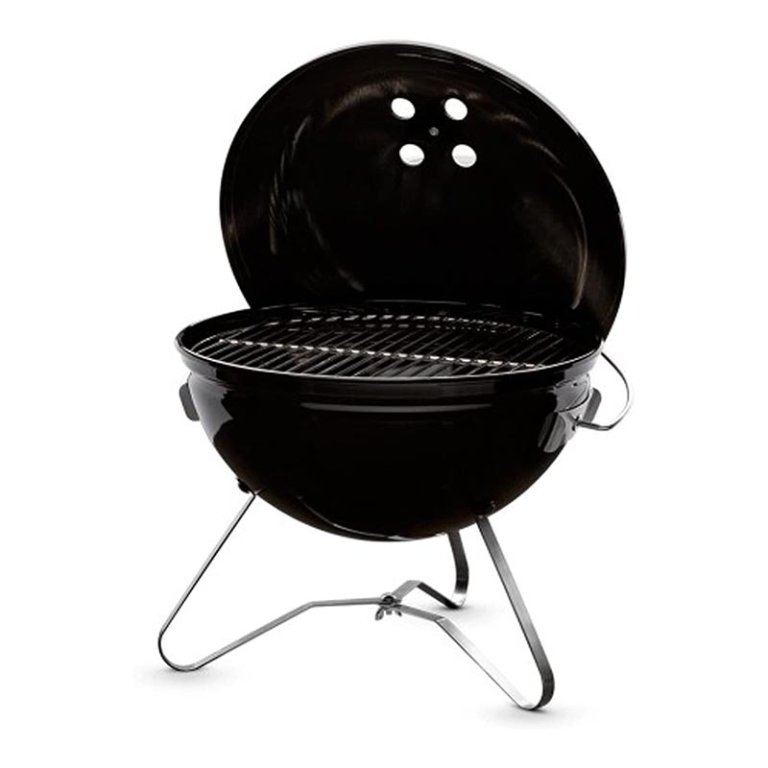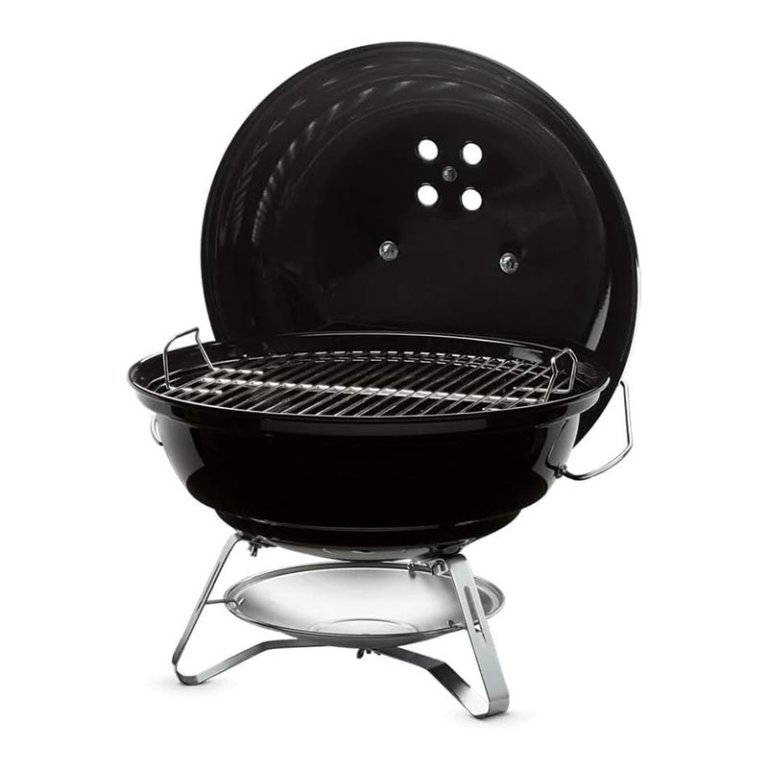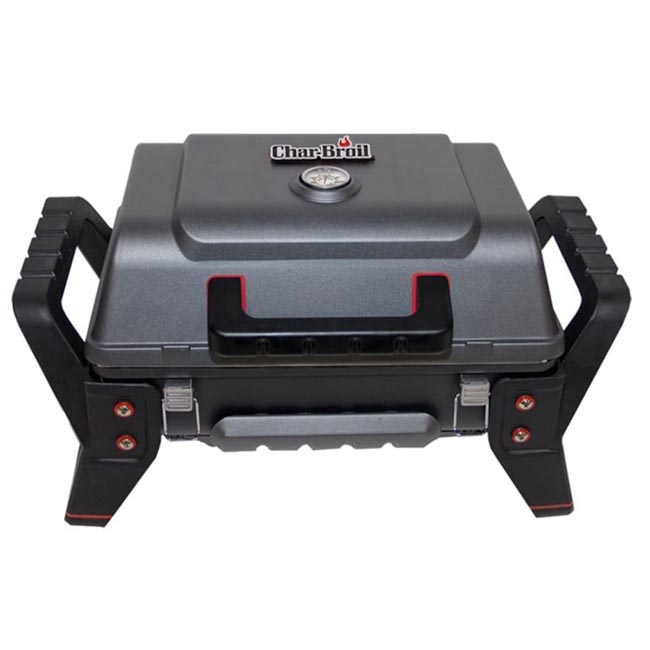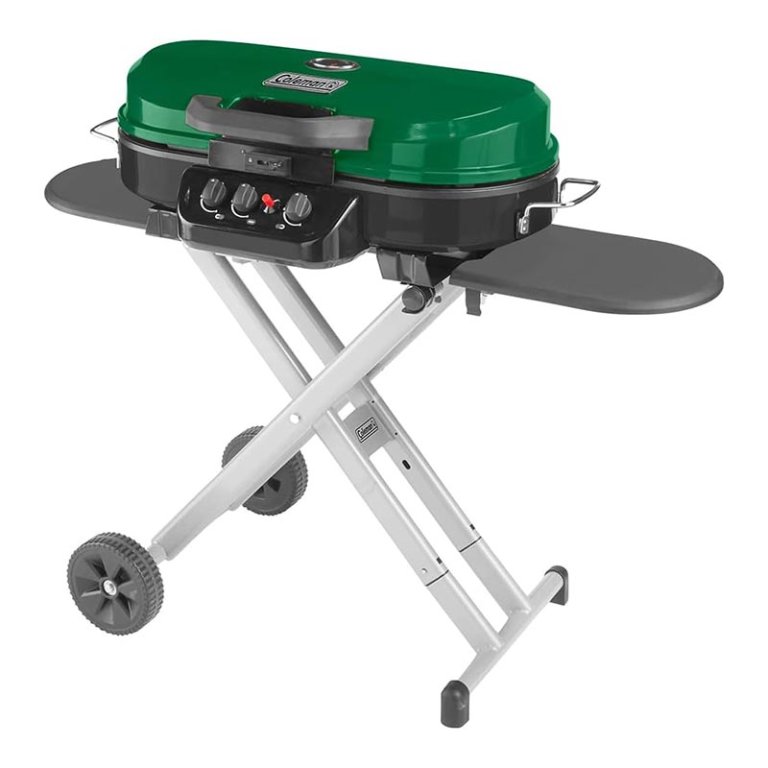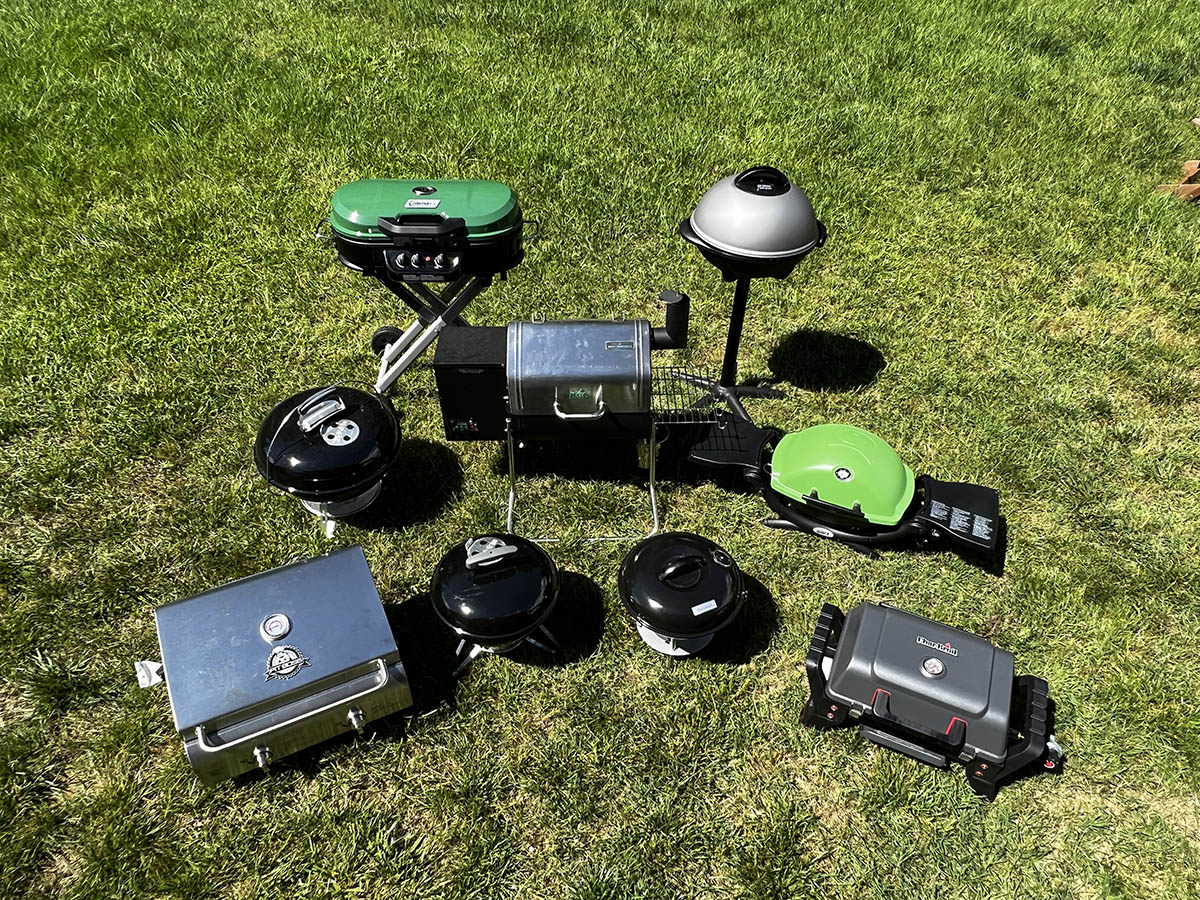
We may earn revenue from the products available on this page and participate in affiliate programs. Learn More ›
To satisfy taste buds on the go—like during a camping trip or in a parking lot before the big game—you’ll want a portable grill. But choosing the right one requires considering variables beyond those involved in purchasing a standard-size model. To find the option that best suits these demands, we tested a variety of different portable grills, including both gas and charcoal models.
Portable grills pack the basic functionalities of their standard counterparts into a more compact design, but reduced size and price tag don’t necessarily indicate reduced quality. Whether you’re craving juicy burgers, hot dogs, seasoned vegetables, or some other barbecue favorite, one of these best portable grills will meet your needs. Our favorite is the Weber Q 1200 Gas Grill due to its battery-powered electric ignition, sear-worthy heat levels, and consistent heat.
Read on to determine what to expect from all of the following portable grill models, and check out specifics that just may suit your preferred fuel source, travel style, and budget.
- BEST OVERALL: Weber Q 1200 Gas Grill
↓ Jump to Review - BEST BANG FOR THE BUCK: Weber Smokey Joe 14-Inch Charcoal Grill
↓ Jump to Review - BEST CHARCOAL GRILL: Weber Jumbo Joe 18-Inch Charcoal Grill
↓ Jump to Review - BEST INFRARED GRILL: Char-Broil Grill2Go X200 Portable Grill
↓ Jump to Review - BEST LIGHTWEIGHT: Cuisinart CCG190 Portable Charcoal Grill
↓ Jump to Review - BEST FOR CAMPING: Coleman RoadTrip 285 Portable Stand-Up Propane Grill
↓ Jump to Review
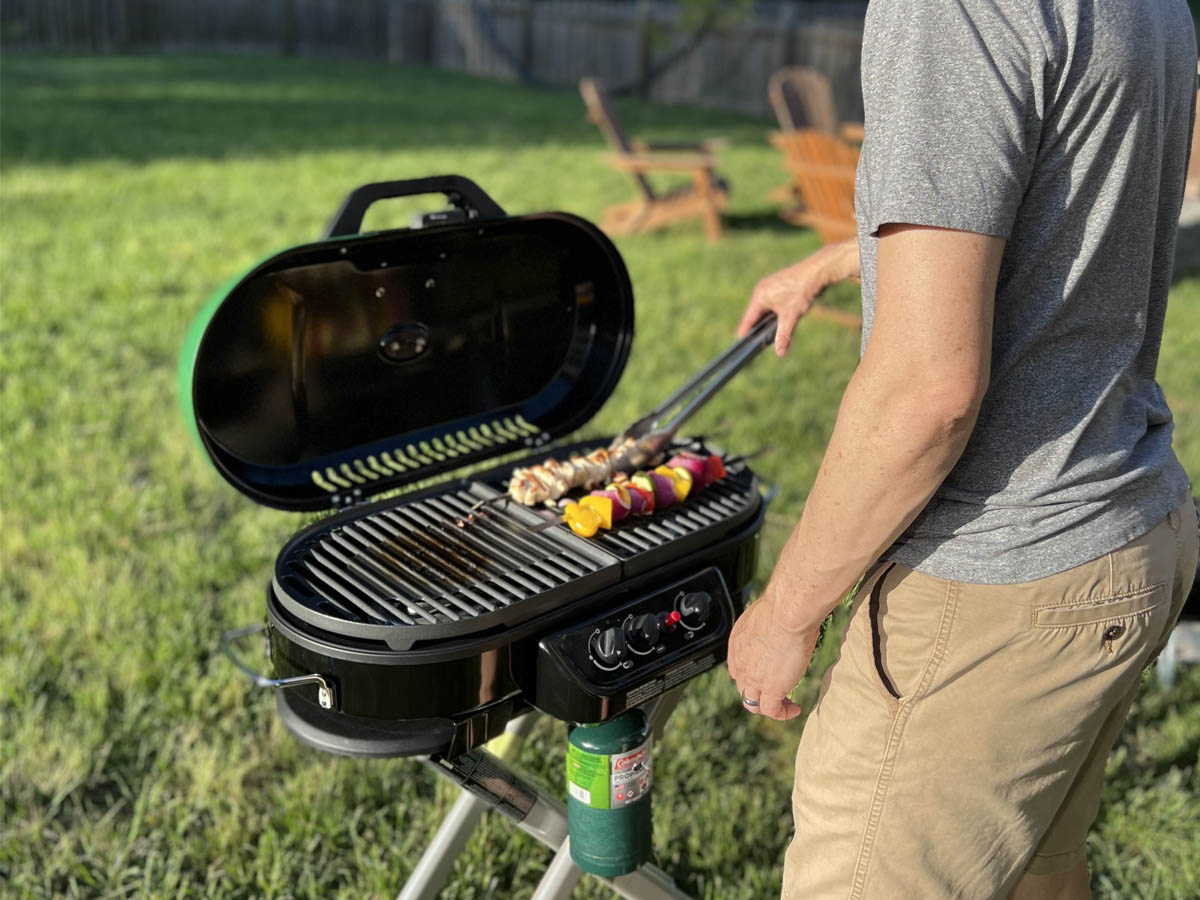
How We Tested the Best Portable Grills
We tested each grill extensively before adding it to our list of the top portable grills. Our assessment began when the grill arrived: We evaluated how easy it was to assemble and set up out of the box.
We then examined how easy it was to light the grill. After giving each grill a chance to heat up, we used a grill thermometer to test the temperature of the grilling surface, keeping in mind that a grill needs to reach 500 degrees Fahrenheit to capably sear meat. For each grill, we cooked a hamburger patty; chicken kabobs with chunks of boneless, skinless chicken breast; and vegetables that included squash, zucchini, onions, and bell peppers. We analyzed how well each grill produced grill marks and was able to create the Maillard reaction that produces the tasty dark-brown crust on meat. For our kabobs, we looked at how evenly the grill roasted when the lid was closed, checking for even cooking in the meat.
After evaluating each grill’s cooking ability, we determined how easy it was to clean the grill. We also looked at what additional features the grill offered, such as smart controls, integrated thermometers, and side tables. Finally, we assessed the grill’s portability by physically carrying each grill to our vehicle and attempting to place it in the trunk.
| Testing Stats | |
| Products tested | 6 |
| Time spent testing | 15 hours |
| Tests performed | 5 to 6 |
| Price range | $29 to $260 |
Our Top Picks
We chose and tested the following small grills. Find out how each of them performed in our tests and why they’re considered some of the best portable grills on the market.
Best Overall
Weber Q 1200 Gas Grill
What We Like
- Easy to set up and transport
- Reaches high temperature for searing
- Easy-to-clean removable plates
- Fold-out side tables for food prep
What We Don’t Like
- More expensive than other portable gas grills
- Only 1 cooking zone
Product Specs
- Type: Propane
- Weight: 31.01 pounds
- Cooking surface: 189 square inches
Our Ratings: Ease of Use 5/5; Heat Distribution 5/5; Portability 5/5; Ease of Cleaning 4.5/5; Value 4.5/5
Weber is highly regarded for the quality and performance of its products, and its grills come at a premium price, so we had high expectations for the Q1200. It didn’t disappoint.
The Q1200 arrives mostly assembled—we were able to get it ready for testing in less than 10 minutes. Lighting it was easy thanks to its battery-powered electric ignition that’s a welcome upgrade over the less reliable piezo ignitions found on many portable gas grills.
After a 15-minute warm-up period, we were pleased to find the cooking surface reached sear-worthy levels of 550 degrees Fahrenheit, which allowed us to achieve dark grill marks and a healthy dark brown crust on our burger patty. The Q1200 fared just as well at roasting as it did searing. With its dome clamshell lid closed, it produced an even internal temperature, resulting in juicy chunks of chicken and evenly cooked veggies from our kabobs. There are also small openings on the sides of the lid that allowed extra clearance for the ends of our skewers.
We liked the consistent heating and thoughtful features on the Q1200. A test with our thermometer revealed even heating across its cooking surface, though it’s important to note that there’s only one burner, so there’s no way to create more than one cooking zone on the Q1200. At 189 square inches, the Q1200’s cooking surface isn’t the largest, but it is certainly above average. We easily could have fit six healthy-size burger patties on it. A built-in thermometer is useful for monitoring temperature while roasting, and the Q1200 comes equipped with small fold-out side tables, creating valuable prep space that we didn’t find on any other portable grill we tested.
Post-grilling cleanup was relatively easy. The two nonstick grill grates and the grease tray can be removed for cleaning in the kitchen sink, and the interior was fairly easy to wipe out.
A portable grill should be manageable to move, and the Q1200 is. We could easily get our arms around it, and at about 31 pounds, it was easy enough to carry a short distance to our small SUV, where it fit easily inside the trunk.
Get the Weber Q1200 portable grill at Amazon, Ace Hardware, or The Home Depot.
Best Bang for the Buck
Weber Smokey Joe 14-Inch Charcoal Grill
What We Like
- Affordably priced
- Doesn’t require a lot of charcoal
- Vents allow for temperature control
- Solidly built
What We Don’t Like
- No way to secure lid to base
- Metal vents can be tricky to operate when hot
Product Specs
- Type: Charcoal
- Weight: 10 pounds
- Cooking surface: 147 square inches
Our Ratings: Ease of Use 3.7/5; Heat Distribution 4/5; Portability 3/5; Ease of Cleaning 3/5; Value 5/5
A smaller version of Weber’s classic kettle grill design, the 14-inch Weber Smokey Joe continues to be one of the best and most affordable portable charcoal grills on the market.
After assembling the grill, which took about 20 minutes, we loaded it up. The nice thing about the Smokey Joe is that it doesn’t require a huge amount of charcoal—it only took about 20 briquettes to fill it up. Per Weber’s recommendation, we used a chimney starter to light the coals, which gave us an even burn across all the briquettes.
With our burgers just inches away from the burning coals, we were able to achieve the Maillard reaction that produces that sought-after tasty brown crust much more easily than on any gas grill. As a result, our burger had a nice crispy crust while remaining juicy on the inside.
We added the lid for our chicken and veggie kabobs. The Smokey Joe comes with a loose lid that doesn’t attach to the base, which is a little inconvenient if you’re looking for a place to put it when it’s blazing hot. The three-hole vents located on the top and bottom of the grill provide ample airflow through the kettle, giving us a surprising amount of control over the Smokey Joe’s internal temperature. However, since the vents are metal, we had to wear grill mitts while adjusting them, which was awkward. Our chicken kabobs came out juicy with a great smoky flavor that can only result from charcoal.
At about 10 pounds and under 15 inches in diameter, the Smokey Joe was easy to carry and took up little space in the trunk of our car. However, it lacked any sort of mechanism to lock the lid to the base, which forced us to carry it in our arms; unfortunately, things got messy. There’s also the potential for it to come apart in transit, dumping leftover charcoal bits and ash into the trunk. Weber does make a premium version of the Smokey Joe that has a lid-locking mechanism, but you’ll pay more for it.
Get the Weber Smokey Joe portable grill at Amazon, The Home Depot, or Walmart.
Best Charcoal Grill
Weber Jumbo Joe 18-Inch Charcoal Grill
What We Like
- Large cooking surface
- Vents allow for temperature control
- Reaches high heats for searing
- Locking lid and handle ideal for transport
What We Don’t Like
- More expensive than other portable charcoal grills
Product Specs
- Type: Charcoal
- Weight: 21.5 pounds
- Cooking surface: 240 square inches
Our Ratings: Ease of Use 4.5/5; Heat Distribution 5/5; Portability 5/5; Ease of Cleaning 5/5; Value 3.5/5
Essentially an oversize version of Weber’s classic 14-inch Smokey Joe grill, the Jumbo Joe expands the cooking surface to the size of a standard charcoal grill while remaining quite portable. Despite being bigger, the Jumbo Joe has a lot in common with its smaller sibling.
It puts out a tremendous amount of heat, doesn’t require a huge amount of charcoal to load (given its 18-inch cooking surface), and remains lightweight. At just 21.5 pounds, the Jumbo Joe is easy to carry from garage to car to campsite. It also has an edge over the standard Jumbo Joe when it comes to portability with a bar that fits over the lid, locking it in place for transport while allowing us to move it from point A to point B by the handle. The bar clip creates a handy holder for the lid when it’s not in use.
Like its little brother, the Jumbo Joe heats evenly and can reach temperatures well above what’s needed for searing. In fact, in our tests, the grill surface got so hot that we needed to keep close tabs on our burger and kabobs to avoid overcooking the outside. This intense heat allowed us to achieve a thick char on the surface of our burger, which turned out juicy and flavor packed.
The Jumbo Joe boasts some 240 square inches of cooking space, and it feels that large. We could easily have loaded a dozen patties onto its cooking surface and still had enough buffer between them to allow for flipping.
With the lid in place, Jumbo Joe’s bulbous kettle shape created an ideal roasting environment for our kabobs. As with the smaller Joe, the vents on the lid and base did an excellent job of controlling oxygen flow into the cooking chamber, which allowed us to control temperature. Though, like the regular Joe, users will want to wear a grill mitt to adjust the metal vents to avoid burns. The Jumbo Joe’s wide base gives it a stable, sturdy feel even when cooking on an uneven lawn.
Cleaning the Jumbo Joe, as with cleaning the smaller version, is pretty straightforward; simply remove the grates and flip the entire grill over to dump the ash and charcoal bits into a trash can. While this is decidedly low tech, it’s easy enough, though we ended up creating a cloud of charcoal dust every time.
Get the Weber Jumbo Joe portable grill at Amazon, BBQGuys, The Home Depot, or Walmart.
Best Infrared Grill
Char-Broil Grill2Go X200 Portable Grill
What We Like
- Reaches high temperature for searings
- Made of durable heavy-gauge aluminum
- Easy to move and set up
- Ample cooking surface
What We Don’t Like
- Produced less flavorful food
- Hard-to-clean grill grate
Product Specs
- Type: Propane
- Weight: 24.71 pounds
- Cooking surface: 200 square inches
Our Ratings: Ease of Use 5/5; Heat Distribution 3.5/5; Portability 5/5; Ease of Cleaning 2/5; Value 3.5/5
The Char-Broil Grill2Go X200 is an infrared grill, which means instead of heating the air, which in turn cooks the food, it heats a stainless steel V-shaped grate that cooks food directly. An infrared grill is in theory supposed to reach temperatures well above what conventional grills can achieve. While the Grill2Go cooks well, we found that its heat output was similar to that of conventional gas grills.
Since the Grill2Go comes almost completely assembled, setup was easy. Its box shape, large handles, and manageable weight made it easy to move into position on a tabletop, and it fit easily into the trunk of our vehicle. We also liked the clips that hold the lid securely closed for transport.
The grill uses a standard 16-ounce propane canister, which attaches to the side of the grill and lights with a piezo ignition. After giving the Grill2Go about 20 minutes to heat up, we recorded a surface temperature of 550 degrees Fahrenheit. Though not the extreme heat that’s advertised with infrared technology, 550 degrees Fahrenheit was more than enough to create a sear on our burger patty. The Grill2Go’s clamshell lid was easy to operate and created even heating when closed. Our kabobs turned out evenly cooked while still being juicy. Though the Grill2Go reached a good heat level and cooked well, we found that the food was not as flavorful as that which came off the other gas grills we tested.
The grill was a bit of a pain to clean: Food and char tended to get caught between the V’s on the grill grate and clog up holes. While the Grill2Go comes with a special scraper, it was still a chore to get the grate clean.
Get the Char-Broil portable grill at Lowe’s or Menards.
Best Lightweight
Cuisinart CCG190 Portable Charcoal Grill
What We Like
- Weighs just under 6 pounds
- Lid attaches to the base
- Requires small amount of charcoal
What We Don’t Like
- Light weight and legs make it feel a bit unstable
Product Specs
- Type: Charcoal
- Weight: 5.85 pounds
- Cooking surface: 150 square inches
Our Ratings: Ease of Use 3.3/5; Heat Distribution 3.5/5; Portability 5/5; Ease of Cleaning 3/5; Value 4.5/5
As one of the lightest portable grills on the market, the Cuisinart CCG190 portable charcoal grill is one of the easiest grills to take to a park or tailgating event. It weighs just 5.85 pounds and features latches that hold the lid to the base, allowing it to be carried by the lid handle.
The Cuisinart uses a kettle style that’s notably shallower than other kettle-style grills. This design has its positives and negatives. On the plus side, the shallow kettle required just 12 briquettes to heat the entire 14-inch cooking surface.
Like other charcoal portable grills, the Cuisinart reached well above the required heat needed to sear meat. Our burger turned out juicy with plenty of charcoal-infused flavor. That alone makes the Cuisinart a great ultralight, budget-priced grill, despite its shortcomings, of which there are a few.
The Cuisinart’s legs don’t spread as widely as the legs on other kettle grills, giving it an unstable feel. Because of the grill’s small leg footprint and light weight, users will want to be cautious while flipping burgers and encountering subsequent resistance; we feared the grill might overturn.
The compact size also created issues when we attempted to roast our kabobs. Closing the lid seemed to stymie airflow to the charcoal, which struggled to stay lit even with both vents wide open. This issue required us to remove and replace the lid periodically, allowing oxygen into the cooking chamber to keep the grill going while cooking our kabobs.
Despite these issues, the Cuisinart produced flavorful food and is a great budget-priced option for those looking for a superlight grill to tote around.
Get the Cuisinart portable grill at Amazon, Lowe’s, The Home Depot, or Walmart.
Best for Camping
Coleman RoadTrip 285 Portable Stand-Up Propane Grill
What We Like
- Folds down and rolls for easy transport
- Reaches high temperatures for searing
- Large cooking surface
- Easy to clean
What We Don’t Like
- Requires 2 people to lift and set up
Product Specs
- Type: Propane
- Weight: 49 pounds
- Cooking surface: 285 square inches
Our Ratings: Ease of Use 4.5/5; Heat Distribution 5/5; Portability 3/5; Ease of Cleaning 4.5/5; Value 4/5
So many portable grills require users to either squat over them or procure a tabletop on which they can be placed. The Coleman RoadTrip 285 portable stand-up propane grill sets itself apart by including its own stand. Although the stand does add to the RoadTrip’s weight, it’s easier to move than many lighter grills. That’s because the RoadTrip folds flat and has wheels on one end, allowing it to roll behind the user like a piece of airline luggage. However, we should note that lifting it into the car trunk and converting it from cart form to grill form can be awkward without two people.
Similar to other gas grills, the Coleman uses 16-ounce propane tanks. And boy, does it get a lot out of that canister. After preheating the grill, the Coleman registered temps approaching 600 degrees Fahrenheit on the surface despite having one of the largest cooking surfaces of any portable camp grill we tested. Coleman uses three burners, including a central circular burner that’s accompanied by two C-shaped burners on either side. This design allowed us to create three possible heat zones, which is impossible to do on most other portable grills. This capability let us grill a burger at sear temperatures on one side while cooking our chicken and vegetable kabobs at a lower temperature on the other side. The Coleman roasted well with the lid closed, although we found the lid’s latch a bit hard to operate.
Cleaning the Coleman is relatively easy. We scrubbed the two nonstick plates in a kitchen sink and removed the large oval shape to wipe out the grease trap.
Get the Coleman portable grill at Amazon or The Home Depot.
Jump to Our Top Picks
What to Consider When Choosing a Portable Grill
Shoppers will want to balance the pursuit of flavor with the desire for convenience. Below is info about factors and features to keep in mind when choosing the right small portable grill. Becoming familiar with these aspects will help you make a smart decision.
Size
Portable grills come in a variety of shapes and sizes, including barrel-shaped and flat and rectangular. Some even resemble a large cook pot with a domed lid. Almost all are small enough to fit in the trunk or seat of most cars in order to be deemed portable, but it’s smart to measure the available space and opt for something that fits within those parameters.
Size matters in terms of grill top area, too: Portable grills range from between 100 and 250 square inches of cooking surface. While a smaller cooktop can typically handle about four hamburgers at a time, the extra 150 square inches means accommodating two more patties or other food items on the grill.
Weight
It’s essential to consider how heavy a grill you’re willing to carry from the house to the car, from the car to the grilling location, and back again. Portable grills tend to weigh anywhere from 5 pounds to a whopping 50 pounds, and that weight can affect portability.
Size and weight don’t necessarily correspond, either, so it may be possible to end up with a small, heavy travel grill or a large, lightweight one. Do your research and know your limits if you want to keep things comfortable for the long haul.
Material
Lots of different materials go into making the ideal portable barbeque grill. The most popular materials include:
- Powder-coated steel: Portable grills made with powder-coated steel are usually the most affordable, as they’re as basic as it gets. They may rust sooner than models made from other materials, but they’re so affordable that some shoppers prefer to replace them every few years rather than buy a pricier grill.
- Stainless steel: Stainless steel portable grills are more rust-resistant and durable than powder-coated grills. They also tend to do a better job of retaining heat, which makes temperature regulation a bit easier.
- Aluminum: Some of the best portable grills feature aluminum fireboxes, which reflect heat evenly and won’t rust. Expect to pay more for these grills and consider them a worthy investment that won’t wind up in the trash in a few years.
The construction of the grates inside the grill also matters. Cast-iron grates are durable but require frequent cleaning and oiling. Stainless steel is also durable and requires very little maintenance but doesn’t distribute heat as evenly as cast iron. Porcelain-coated cast iron provides the best of both worlds. The downside is that cast iron is quite heavy so is less suitable for some portable grills.
Style
The best grills are all about utility, and they come in a variety of different styles to suit user preferences.
- Some models are designed to sit on top of a picnic table or bench.
- Portable grills with frames that unfold or stands that extend make transport easy while still allowing the user to grill from a comfortable height.
- Kamado-style grills are oval shaped and feature thick insulated walls for maximum heat retention.
- Flattop grills operate like traditional portable gas grills without lids, but their stainless steel tops act like griddles.
- Certain electric grills don’t use a flame or create carbon monoxide and are so compact that they can cook on a kitchen counter.
Heat Output and Control
Choosing a portable grill can often come down to ease of use and the amount of heat produced. Many of the best portable gas grills make adjusting the temperature incredibly easy with dials that clearly indicate low, medium, and high temperatures. For a portable pellet grill, temperature adjustment is related to the speed at which pellets are fed into the grill. For charcoal-style grills, control amounts to how much charcoal is burning.
Heat output depends on the size of the grill. Smaller grills can manage with 8,000 British thermal units (BTUs), while larger models might need 20,000 BTUs per burner. As a guideline, consider that heat output should be between 80 and 100 BTUs per square inch of cooking surface.
Additional Features
Some portable grills may come with additional features to make them easier to operate, more convenient, and more useful. An example of a built-in feature might be hooks for hanging grilling tools, keeping tongs and a spatula within easy reach.
Many gas-powered grills feature an electronic push-button ignition to fire up the fuel source quickly. This convenient feature can send a near-constant spark until the grill lights, unlike striker-style ignitions that take repeated pressing.
Some portable grills also come in carrying cases or bags, making it simpler to transport them from a vehicle and store them neatly.
Portable Grill Power Sources
There are quite a few different ways to power a portable grill. This section will outline some of the most common fuel sources and grill types, highlighting the pros and cons of each type as well as important considerations of each fuel source.
Charcoal
Barbecue purists prefer the smoky taste that can only be achieved with charcoal briquettes. Charcoal burns hotter than propane, producing a more severe sear on food, but using it creates a few hassles: It can be messy, heavy to move, and slow to reach the desired heat level for cooking.
Propane
Propane offers a quick, easy way to fire things up—and cleanup is minimal once things have cooled down. Some propane grills even feature infrared heat, which heats very evenly and can be safer for a tabletop propane grill. Of course, the main drawback is the lack of charcoal flavor. The efficiency of propane is also pricier since grills that use this type of fuel are typically more expensive than their charcoal-burning counterparts.
Natural Gas
Portable gas grills that work with natural gas operate similarly to propane units, but the gas nozzles that control the fuel are different. They’re efficient and easy to light, and controlling the temperature is almost intuitive. Portable natural gas grills can’t provide the flavor of charcoal grills, are not as common as other types of portable grills, and tend to cost more than propane models.
Pellet
Grilling with wood pellets has become quite popular, and smaller portable pellet grills are now available. Some might argue that pellet grills offer the best flavor, and they also have easy temperature adjustments. However, pellet grills are often much more expensive than charcoal, propane, or electric grills. Plus, some models are modular, meaning setup could be time-consuming and complicated.
Electric
The simplest and most transportable portable grills are electric. They don’t provide the flame-kissed flavor of a charcoal grill, but temperature adjustments are pinpoint. Portable electric grills are usually very small. It’s even possible to use some electric grills indoors, but of course they need to be plugged into an outlet, generator, or vehicle’s 12-volt outlet.
FAQs
Even with ample background on the portable grills, you might still have some additional questions. Read on for answers to some of the most common queries about portable grills.
With a portable grill, a 1-pound propane cylinder typically gives you around 2 hours of cooking time. A 20-pound tank can last about 20 hours, depending on the grill’s BTU rating and how high you set the heat.
The best fuel type for a portable grill depends on your needs. Propane is popular for its convenience and ease of use. Charcoal provides a classic smoky flavor but requires more setup and cleanup. Electric grills are great for areas with restrictions on open flames.
To set up a portable grill, start by placing it on a stable, level surface. If using propane, securely attach the propane cylinder and check for leaks. For charcoal, fill the grill with charcoal briquettes and light them. Allow the grill to heat up before placing food on the grates.
It’s not recommended to put a portable camping grill on a plastic table, as the heat from the grill can cause the plastic to melt or warp. Instead, use a heat-resistant surface like a metal or wooden table designed to withstand high temperatures.
Portable grills typically last between 3 to 10 years, depending on the quality of the materials, frequency of use, and how well they are maintained. Regular cleaning and proper storage can extend the lifespan of a portable BBQ grill.
Portable grills may be worth it if you enjoy outdoor cooking, camping, or tailgating. They offer convenience, flexibility, and the ability to grill on the go. Their compact size and portability make them a valuable alternative to full-size grills.
Meet the Tester
Tony Carrick is a freelance writer specializing in home improvement, landscaping, technology, home security, and design. His articles have been featured on such sites as Angi, Popular Science, Futurism, 360 Reviews by U.S. News & World Report, Domino, and more. Carrick has conducted rigorous product testing on everything from power tools to home security systems to backyard grills. With each review, his goal is to help readers determine whether a product meets their needs and if it is or isn’t worth its price tag.
Additional research provided by Tom Scalisi and Andréana Lefton.

